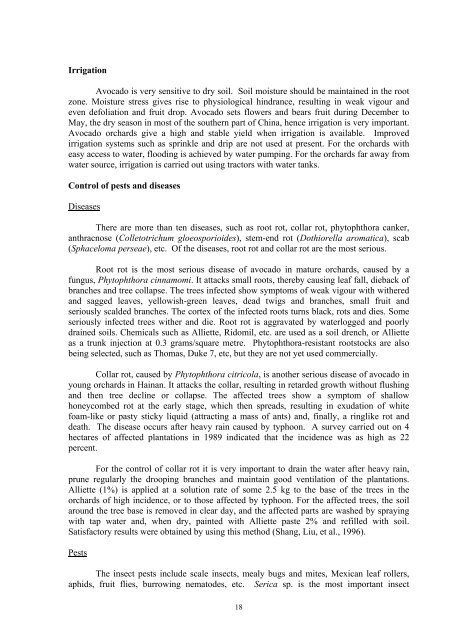Avocado Production in Asia and the Pacific - United Nations in ...
Avocado Production in Asia and the Pacific - United Nations in ...
Avocado Production in Asia and the Pacific - United Nations in ...
Create successful ePaper yourself
Turn your PDF publications into a flip-book with our unique Google optimized e-Paper software.
Irrigation<br />
<strong>Avocado</strong> is very sensitive to dry soil. Soil moisture should be ma<strong>in</strong>ta<strong>in</strong>ed <strong>in</strong> <strong>the</strong> root<br />
zone. Moisture stress gives rise to physiological h<strong>in</strong>drance, result<strong>in</strong>g <strong>in</strong> weak vigour <strong>and</strong><br />
even defoliation <strong>and</strong> fruit drop. <strong>Avocado</strong> sets flowers <strong>and</strong> bears fruit dur<strong>in</strong>g December to<br />
May, <strong>the</strong> dry season <strong>in</strong> most of <strong>the</strong> sou<strong>the</strong>rn part of Ch<strong>in</strong>a, hence irrigation is very important.<br />
<strong>Avocado</strong> orchards give a high <strong>and</strong> stable yield when irrigation is available. Improved<br />
irrigation systems such as spr<strong>in</strong>kle <strong>and</strong> drip are not used at present. For <strong>the</strong> orchards with<br />
easy access to water, flood<strong>in</strong>g is achieved by water pump<strong>in</strong>g. For <strong>the</strong> orchards far away from<br />
water source, irrigation is carried out us<strong>in</strong>g tractors with water tanks.<br />
Control of pests <strong>and</strong> diseases<br />
Diseases<br />
There are more than ten diseases, such as root rot, collar rot, phytophthora canker,<br />
anthracnose (Colletotrichum gloeosporioides), stem-end rot (Dothiorella aromatica), scab<br />
(Sphaceloma perseae), etc. Of <strong>the</strong> diseases, root rot <strong>and</strong> collar rot are <strong>the</strong> most serious.<br />
Root rot is <strong>the</strong> most serious disease of avocado <strong>in</strong> mature orchards, caused by a<br />
fungus, Phytophthora c<strong>in</strong>namomi. It attacks small roots, <strong>the</strong>reby caus<strong>in</strong>g leaf fall, dieback of<br />
branches <strong>and</strong> tree collapse. The trees <strong>in</strong>fected show symptoms of weak vigour with wi<strong>the</strong>red<br />
<strong>and</strong> sagged leaves, yellowish-green leaves, dead twigs <strong>and</strong> branches, small fruit <strong>and</strong><br />
seriously scalded branches. The cortex of <strong>the</strong> <strong>in</strong>fected roots turns black, rots <strong>and</strong> dies. Some<br />
seriously <strong>in</strong>fected trees wi<strong>the</strong>r <strong>and</strong> die. Root rot is aggravated by waterlogged <strong>and</strong> poorly<br />
dra<strong>in</strong>ed soils. Chemicals such as Alliette, Ridomil, etc. are used as a soil drench, or Alliette<br />
as a trunk <strong>in</strong>jection at 0.3 grams/square metre. Phytophthora-resistant rootstocks are also<br />
be<strong>in</strong>g selected, such as Thomas, Duke 7, etc, but <strong>the</strong>y are not yet used commercially.<br />
Collar rot, caused by Phytophthora citricola, is ano<strong>the</strong>r serious disease of avocado <strong>in</strong><br />
young orchards <strong>in</strong> Ha<strong>in</strong>an. It attacks <strong>the</strong> collar, result<strong>in</strong>g <strong>in</strong> retarded growth without flush<strong>in</strong>g<br />
<strong>and</strong> <strong>the</strong>n tree decl<strong>in</strong>e or collapse. The affected trees show a symptom of shallow<br />
honeycombed rot at <strong>the</strong> early stage, which <strong>the</strong>n spreads, result<strong>in</strong>g <strong>in</strong> exudation of white<br />
foam-like or pasty sticky liquid (attract<strong>in</strong>g a mass of ants) <strong>and</strong>, f<strong>in</strong>ally, a r<strong>in</strong>glike rot <strong>and</strong><br />
death. The disease occurs after heavy ra<strong>in</strong> caused by typhoon. A survey carried out on 4<br />
hectares of affected plantations <strong>in</strong> 1989 <strong>in</strong>dicated that <strong>the</strong> <strong>in</strong>cidence was as high as 22<br />
percent.<br />
For <strong>the</strong> control of collar rot it is very important to dra<strong>in</strong> <strong>the</strong> water after heavy ra<strong>in</strong>,<br />
prune regularly <strong>the</strong> droop<strong>in</strong>g branches <strong>and</strong> ma<strong>in</strong>ta<strong>in</strong> good ventilation of <strong>the</strong> plantations.<br />
Alliette (1%) is applied at a solution rate of some 2.5 kg to <strong>the</strong> base of <strong>the</strong> trees <strong>in</strong> <strong>the</strong><br />
orchards of high <strong>in</strong>cidence, or to those affected by typhoon. For <strong>the</strong> affected trees, <strong>the</strong> soil<br />
around <strong>the</strong> tree base is removed <strong>in</strong> clear day, <strong>and</strong> <strong>the</strong> affected parts are washed by spray<strong>in</strong>g<br />
with tap water <strong>and</strong>, when dry, pa<strong>in</strong>ted with Alliette paste 2% <strong>and</strong> refilled with soil.<br />
Satisfactory results were obta<strong>in</strong>ed by us<strong>in</strong>g this method (Shang, Liu, et al., 1996).<br />
Pests<br />
The <strong>in</strong>sect pests <strong>in</strong>clude scale <strong>in</strong>sects, mealy bugs <strong>and</strong> mites, Mexican leaf rollers,<br />
aphids, fruit flies, burrow<strong>in</strong>g nematodes, etc. Serica sp. is <strong>the</strong> most important <strong>in</strong>sect<br />
18
















